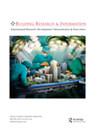西班牙北部社会住房居民室内环境质量感知的多因素方法
IF 3.7
3区 工程技术
Q1 CONSTRUCTION & BUILDING TECHNOLOGY
引用次数: 1
摘要
由于年龄和社会经济条件的原因,社会住房使用者通常更容易受到伤害,并且必须处理与易受不良室内环境影响相关的具体问题。目前的住房模式不能满足家庭结构及其需求的多样性,因此,必须将居民的观点纳入改善其生活质量、健康和舒适的过程中。本研究旨在分析影响公屋室内环境质素及舒适度的因素。它还旨在研究居住者与住宅特征相关的感知舒适度。为了实现本研究的目标,采用多因素方法对西班牙巴斯克自治区16栋公共租赁存量建筑中的283户住宅样本进行了分析,数据来自冬季进行的一项调查。对感知室内环境中事件变量的分析支持了居住者视角的影响以及他们在舒适度分析中反应的主观性,并为社会住房的物理特征与家庭感知舒适度之间的关系提供了新的见解。本文章由计算机程序翻译,如有差异,请以英文原文为准。
Multifactorial approach to indoor environmental quality perception of social housing residents in Northern Spain
ABSTRACT Social housing users are generally more vulnerable due to age and socioeconomic conditions and have to deal with specific problems related to vulnerability to poor indoor environment exposure. The current housing model does not respond to the diversity of family structures and their needs, and it is, therefore, essential to integrate residents’ perspectives into the process of improving their quality of life, health and comfort. This study aims to analyse the factors that influence the perceived Indoor Environmental Quality and comfort of public rental housing. It also aims to study occupants’ perceived comfort in relation to the characteristics of the dwellings. To achieve the objective of the study, a multifactorial approach has been applied to a sample of 283 dwellings in 16 buildings of the public rental stock in the Autonomous Community of the Basque Country, Spain, with data obtained in a survey conducted in the winter. The analysis of the incident variables in the perceived indoor environment supports the idea of the influence of occupants’ perspectives and the subjectivity of their responses in the comfort analyses and provides new insight into the relationship between the physical characteristics of social housing and households’ perceived comfort.
求助全文
通过发布文献求助,成功后即可免费获取论文全文。
去求助
来源期刊

Building Research and Information
工程技术-结构与建筑技术
CiteScore
8.60
自引率
7.70%
发文量
43
审稿时长
>12 weeks
期刊介绍:
BUILDING RESEARCH & INFORMATION (BRI) is a leading international refereed journal focussed on buildings and their supporting systems. Unique to BRI is a focus on a holistic, transdisciplinary approach to buildings and the complexity of issues involving the built environment with other systems over the course of their life: planning, briefing, design, construction, occupation and use, property exchange and evaluation, maintenance, alteration and end of life. Published articles provide conceptual and evidence-based approaches which reflect the complexity and linkages between cultural, environmental, economic, social, organisational, quality of life, health, well-being, design and engineering of the built environment.
 求助内容:
求助内容: 应助结果提醒方式:
应助结果提醒方式:


